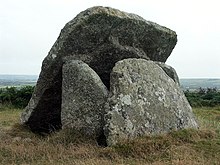Quoit
A quoit is a portal grave from the Neolithic Age in which several vertical megaliths support the single cover plate. These dolmens were also known as cromlechs in the 19th century .
Occurrence
Systems of this type can be found in Cornwall , Wales and Ireland . There they are known as "tripod dolmen" as a special form of portal tombs .
The best-known Quoit in Cornwall is the Lanyon Quoit , the best preserved is the Chûn Quoit , and the archaeologically most interesting is the Trethevy Quoit . Other Cornish quoits include a. the restored Giant's or Carwynnen Quoit, the Bosporthennis Quoit , the Mulfra Quoit and the Zennor Quoit . A ruined specimen is the Sperris Quoit.
In Wales there are a. in Pembrokeshire, the Arthur's Quoit , the Carreg Coetan Arthur , the Collapsed Devil's Quoit , the Llech-Y-Tripedd , the King's Quoit, and the Quoit of Pentre Ifan .
Word origin
In 1769, William Borlase first explained the origin of the name Quoit in a publication : When describing the Chûn Quoit, he stated that the name can be traced back to the disc-shaped capstone of this dolmen, the shape of which is reminiscent of a throwing disc (Quoit). The word quoit appears for the first time in the 14th century, initially means a flat throwing stone or throwing ring and is also used for the traditional throwing game of the same name.
Dating
Recent excavations and the dating of the bone finds showed that the megalithic systems in the Neolithic between 3700 and 3300 BC. BC and were also used as community graves for a long time. Even in the Bronze Age cremations took place in front of or on these grounds. The ashes were then buried in pits or urns .
particularities
The special thing about these systems is that all buildings that consisted of smaller stone formats and earthworks have mostly been completely removed or put to another use, so that the original appearance is difficult to reconstruct. Modern research assumes that these systems were not completely covered with earth, but had a free entrance area.
It is noticeable that many of the quoits are in places with a panoramic view of hills, rivers or coastal regions. Some researchers believe that this claimed a specific area and that the community should develop a closer relationship with that area. This was probably supported with corresponding cult acts. The transition from hunter-gatherer cultures to sedentarism with domesticated animals is expressed in these and similar buildings.
Individual evidence
- ^ William Borlase: Antiquities Historical and Monumental of the County of Cornwall , Bowyer and Nichols, London 1769
- ^ William Borlase: Antiquities Historical and Monumental of the County of Cornwall , Bowyer and Nichols, London 1769
- ↑ Terry Hoad: The Concise Oxford Dictionary of English Etymology , Oxford University Press 1996
- ^ John Barnatt: Prehistoric Cornwall: The Ceremonial Monuments , Turnstone Press Limited 1982
- ^ John Barnatt: Prehistoric Cornwall: The Ceremonial Monuments , Turnstone Press Limited 1982
- ↑ http://www.historic-cornwall.org.uk/a2m/neolithic/chambered_tomb/chun_quoit/chun_quoit.htm
- ↑ http://www.historic-cornwall.org.uk/a2m/neolithic/ne_menu.htm
literature
- John Barnatt: Prehistoric Cornwall: The Ceremonial Monuments . Turnstone Press Limited 1982, ISBN 0855001291 .
- Ian McNeil Cooke: Standing Stones of the Land's End . Cornwall: Men-an-Tol Studio 1998, ISBN 0951237195 .



